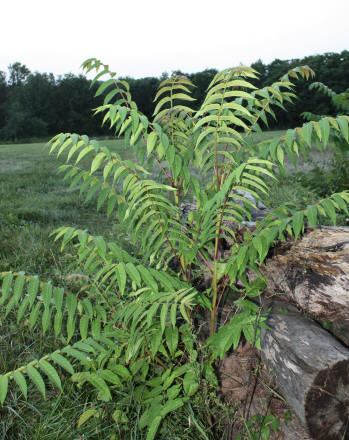Noxious and Invasive Plants of the Mason-Dixon
Rusty Ryan
(8/2011) In my travels throughout Adams County I am overwhelmed of the diversity and dominance of invasive and noxious plants within our developed areas, public lands and especially along our roadways.
I’m sure the same could be said of the other Counties along the Mason-Dixon.
An invasive plant is a species that has become a weed pest by growing aggressively, spreading, and displacing other plants. Invasive plants thrive in disturbed areas and most invasive plants have been
introduced from other countries and are not native to this area. A noxious weed is an invasive plant taken to the highest level. In Pennsylvania, a noxious plant is defined by the Noxious Weed Law of PA as "a plant that has been
determined to be injurious, to public health, crops, livestock, agricultural land or other property".
The most obvious noxious plant that is very visible now is the Canada Thistle. Unfortunately, this plant has gone to seed and the damage is done. Control will not be necessary till next year. Even worse
is the fact that many of those same fields were recently harvested while the plants were in full seed thus the thistle that was cut and mixed with desirable crops will be spread to other places. It is also very doubtful that the
equipment operator took the time to properly clean the harvesting equipment prior to harvesting the next fields.
Why worry about invasive and noxious plants? The two main reasons to worry are loss of biodiversity and economics. Invasive and noxious plant (and animal) issues are second only to loss of habitat in
terms of loss of biodiversity. Both plant types displace and out compete with our native plants for survival. In turn, our native plants and animals suffer. Even entire ecosystems can be taken over by a single plant. For
example, a single plant can dominate our wetland ecosystems and provide little to no value such as the noxious plant called Purple Loosestrife.
|

Ailanthus (tree of heaven)
|
Invasive plants of noteworthy in Adams County include Ailanthus (tree of heaven); Japanese Stilt grass, various honeysuckle species, Japanese knotweed, Japanese barberry and Garlic mustard. A complete
list is available @ www.dcnr.state.pa.us.
In Adams County, there are two species that the local Conservation District is hoping to control. They are Purple Loosestrife and Japanese Knotweed. These two species are present in the County but the
populations are small and scattered. These two species are found around wetlands and streams and they can devastate ecosystems in and along our aquatic resources. A goal of the Conservation District is to inform property owners
of the presence of these two species. Once detected and property owner known, the District will inform the property owner of the issue and provide information for the control of the specie.
Noxious Weeds – The state of Pennsylvania does have a Law which makes it illegal to propagate, sell or transport the following plant species: Marijuana, Canada thistle, Multiflora rose, Shattercane,
Johnson grass, Purple loosestrife, Giant hogweed, Kudzu-vine, Mile-a minute, Jimsonweed, Goatsrue, Bull/Spear thistle and Musk/Nodding thistle.
Maryland also has a Weed Control Law that regulates six plants. They are: Canada Thistle, Johnsongrass, Shattercane, Bull Thistle, Plumeless Thistle and Musk/Nodding Thistle. During my research, it
appears that Maryland also has a separate Law that deals with the management of Multi-flora rose but I could not access the information during my internet search.
Control Methods
The problem with both noxious and invasive plants is that they are difficult and costly to control. Control methods include mechanical, cultural, chemical and biological.
Mechanical control can consist of methods such as mowing, pulling, digging and cutting.
Cultural control - an example of this method would be cleaning equipment before leaving an infected area thus minimizing transport to unaffected sites.
Chemical control methods usually consist of applying specific herbicides.
Biological control consists of introducing a pest (insect or disease) from the plants native origin.
Invasive and noxious plants also take a heavy economic toll in this country. A Cornell University study estimated that it cost Americans 138 billion dollars to deal with issues pertaining to control of
exotics (includes plants and animals).
What can you do?
Learn to identify the various plants. Once identified, create a plan of how best to control those unwanted plants on your own property. It is very important to frequently scout your property at different
times of year. Identifying and treating them before they flower is best.
Landscape with native plants. Avoid buying non-native plants.
Minimize soil disturbance. Disturbing soil is a prime way to attract those unwanted plants.
Make sure that equipment is cleaned to reduce transport of noxious and invasive plants. This is something you should insist on when contracting others to manage your property (i.e. mowing services and
crop harvesting).
** Remember that controlling those plants is much easier when the plants are detected early and in small numbers!
Read other articles by Rusty Ryan